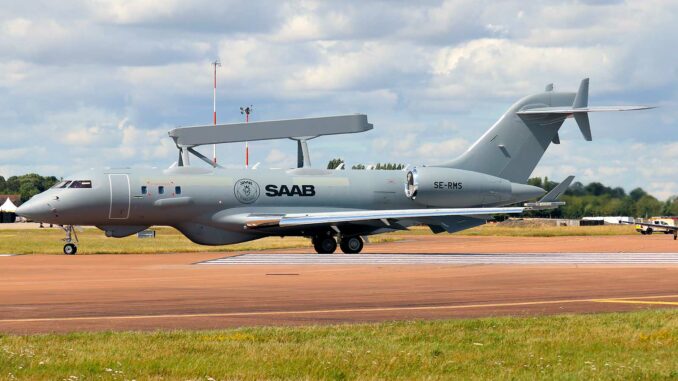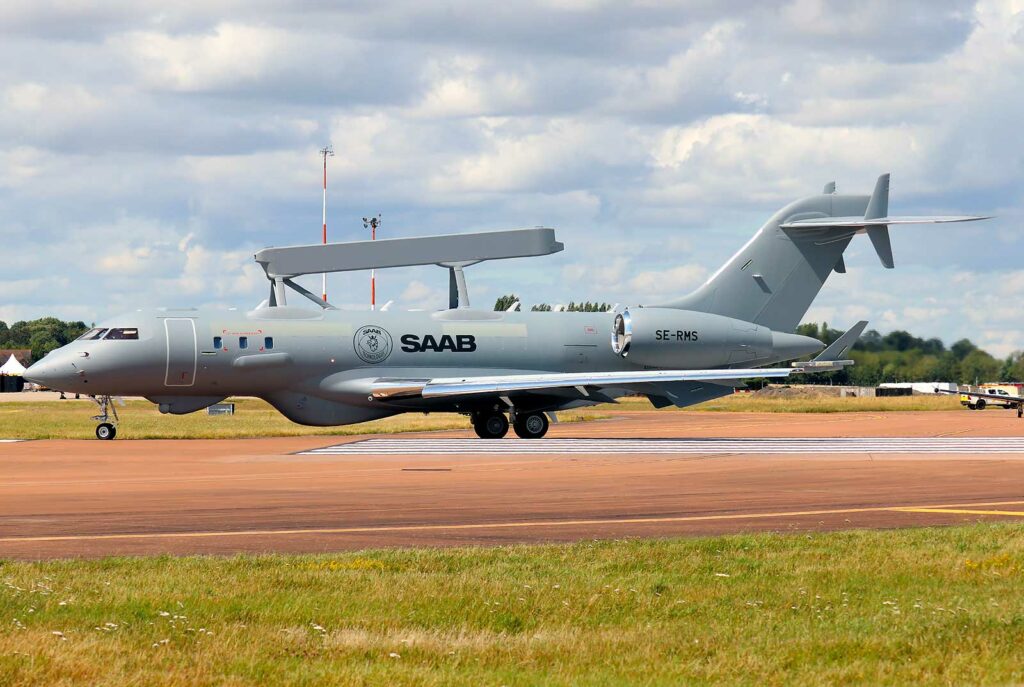
The GlobalEye combines multi-domain sensors, AI, and in-flight command to provide a unique tactical picture. Technical analysis of an early warning platform.
Summary
The GlobalEye is an airborne warning and command platform designed to collect, fuse, and disseminate a massive amount of information from the air, sea, and land domains in real time. Its strength lies in its ability to automatically manage all data from active and passive radars, create a unified operational view (Recognized Situational Picture) and transmit it in the form of orders or recommendations via a multi-domain Command & Control system. The system also features artificial intelligence and machine learning algorithms capable of identifying emerging patterns or threats and reducing the cognitive load on the crew. Compared to traditional AEW&C warning platforms, GlobalEye stands out for its true multi-sensor integration, its role as a flying command center, and its strategic interconnection.
GlobalEye: a multi-domain airborne platform
The aircraft and its characteristics
GlobalEye uses the Bombardier Global 6000/6500 business jet as its airframe, giving it an operational range of over 11 hours. On board, the main radar is the Erieye ER, with an AESA antenna, housed under the visible dorsal dome (“ski box”) approximately 10 m long. Saab reports detection ranges of around 650 km (350 NM) or more for certain threats. The aircraft can detect very low-flying threats, such as an object at 200 feet (~60 m) at an altitude of 35,000 ft (~10,700 m) over a distance of more than 458 km.
The advantage of this platform is that it replaces what were once several specialized aircraft: airborne radar, maritime surveillance, and mobile ground detection. It combines several functions in a single mission.
Sensors and multi-domain integration
The GlobalEye combines:
- an Erieye ER radar for air surveillance, in S-band or L-band, with electronic scanning.
- a specialized maritime radar (e.g., the Seaspray 7500E) to detect naval targets, small boats, and shallow-diving submarines.
- Optronic systems (thermal and infrared cameras) and a Ground Moving Target Indication (GMTI) mode for ground surveillance.
- Electronic warfare (ESM/ELINT) and automated target identification (AIS, IFF) suites.
The fusion of these sensors enables GlobalEye to build a unified picture of the situation in all three domains. This is not simply the addition of multiple sensors, but centralized processing that eliminates duplication, correlates tracks, and produces reliable tracks for the crew and connected forces.
Data fusion and in-flight command
Automated fusion capability
One of the key technologies is Saab’s Track Data Fusion Engine (TDFE), designed to aggregate streams from active/passive sensors and provide a single reliable track per target. It operates in the air, surface, and subsurface domains, can support more than 100 sensors, and operates in automatic, semi-automatic, or manual mode. ([Start][4]) In fact, the GlobalEye crew receives a consolidated image—rather than multiple streams to combine—which reduces latency and the risk of error.
Compared to older systems, where each sensor remained “proprietary,” GlobalEye offers reduced decision time and greater consistency in threat recognition.
Multi-domain Command & Control
GlobalEye also acts as a flying command center: it can track up to 1,000 targets simultaneously in the air, sea, and land domains (according to manufacturer specifications). It is equipped to transmit data to friendly forces via data links, SATCOM systems, and tactical networks.
The crew operates in a mission-command environment with multiple multifunctional consoles, optimized human-machine displays, and real-time data streams. GlobalEye even allows sensors to be redistributed to other platforms, aircraft or ships to be guided, and joint missions to be coordinated. This transforms the aircraft into the nerve center of the theater of operations.
Integration of AI and machine learning
To absorb the volume of data, Saab is introducing artificial intelligence and machine learning into the system. These technologies make it possible to detect activity patterns, flag anomalies, prioritize relevant leads, and reduce the cognitive load on operators. AI adds value to the concept of data fusion: no longer just combining, but analyzing and anticipating.
Thanks to these functions, the crew can focus on critical decisions rather than on manual data collection and management. This is a qualitative leap forward compared to some competitors who focus more on the platform than on the intelligence of the system.

Missions, use, and integration into the armed forces
Types of missions covered
GlobalEye can perform a wide range of missions:
- Theater surveillance: wide-area air, sea, and land coverage.
- Low-altitude threat detection: fast ships, stealth drones, shallow-diving submarines.
- Command and control: coordination of squadrons, naval groups, or ground forces.
- Data exchange and tactical liaison: information relay for other platforms or ground forces.
- Dual use in peacetime: disaster monitoring, civil or maritime response coordination.
For example, Saab reports that the version can detect flying threats at 35,000 ft and 458 km and monitor jet boats or even periscopes with its maritime radar.
Use within the armed forces
The GlobalEye is in service in the United Arab Emirates, delivered since 2020, and Sweden has ordered two aircraft for delivery in 2027. Tactical integration involves the creation of a network of missions, sensors, and combat units. The aircraft provides warning, reconnaissance, command, and redistributes information. It allows ground and naval forces to gain response time and consistency.
Comparison with other AEW&C aircraft
Compared to platforms such as the Boeing E-7 or Northrop Grumman E-2D, the GlobalEye stands out for:
- extended range (>11 hours) and business jet logistics.
- broader multi-domain (air-sea-land) coverage than conventional AEW aircraft.
- a more integrated data and command architecture.
The AEW&C market trend is indeed shifting back toward lighter, more connected platforms with rapid software updates. The GlobalEye is therefore part of the new generation.
Strengths, challenges, and prospects for development
Major strengths
- Automatic multi-sensor data fusion enables greater consistency and speed of action.
- The role of flying C2 center transforms the surveillance mission into a tactical engagement mission.
- The use of AI and machine learning provides real-time decision support.
- The multi-domain concept allows armies to leverage a single asset for multiple combat domains.
Limitations and challenges
- Acquisition and operating costs remain high.
- Effectiveness is highly dependent on tactical connectivity and customer data links.
- The mission requires support platforms (refueling, forward bases) in certain theaters.
- Data integration and cybersecurity are becoming critical issues: a flying command node is also a target.
Possible future developments
- Extension of the AI suite to include predictive and increased automation functions.
- Adaptation for drone swarm missions or interoperability with UAVs.
- Frequent software updates to keep pace with emerging threats (hypersonic, UAS).
- Integration into multi-platform networks (ships, satellites, drones) for distributed management of tactical awareness.
GlobalEye represents a significant advance in surveillance and command system architecture. By combining sensors, AI, and multi-domain C2 in a single aircraft, it embodies the transition to a form of warfare where information, speed, and connectivity take precedence over raw power alone. In a world where threats are rapidly evolving, this platform offers a coherent response to real-time requirements. It remains to be seen how each military will fully exploit this potential in its integrated weapons and intelligence network.
Sources
Saab AB – GlobalEye AEW&C product sheet.
Saab AB – Track Data Fusion Engine (TDFE) product sheet.
Wikipedia – GlobalEye.
Defense Advancement – article “Sweden orders two GlobalEye airborne early warning aircraft.”
War Wings Daily is an independant magazine.